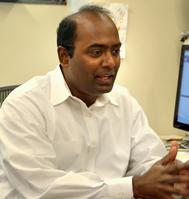Purdue wins grant for investigating, improving disaster recovery
Purdue University Civil Engineering researchers are leading an effort to determine how communities can better, and more quickly, recover after a natural disaster strikes.
The National Science Foundation issued a $2.5 million Critical Resilient Interdependent Infrastructure Systems and Processes (CRISP) grant to a research team with Professor of Civil Engineering Satish Ukkusuri serving as principal investigator. The team will research how the U.S. can more efficiently allocate resources, better prepare, and reduce the time and cost of recovery when a community is struck by a disaster.
In addition to Ukkusuri, the multi-university and multi-disciplinary team consists of Purdue professors Shreyas Sundaram of the School of Electrical and Computer Engineering, Seungyoon Lee of the Brian Lamb School of Communication, and associate professor Laura Siebeneck from the University of North Texas Department of Emergency Management and Disaster Science. Ukkusuri says this eclectic group was chosen because he wants to study how a disaster affects a community from all angles.
Studying Disaster Recovery Data
“We want to learn why some communities recover faster than others, while some never recover at all, ”Ukkusuri says. “If we can find the answers to these questions, then I think the project is well-served.”
Ukkusuri’s team will begin the four- to five-year study in January 2017 by collecting data from communities impacted by Hurricane Sandy in New York and New Jersey. The team will create and test modeling
approaches for improved knowledge of social factors (such as how one’s involvement in the community affects one’s willingness to return to the neighborhood) as well as physical factors (such as road and
infrastructure repair) that lead to recovery.
Modeling, Predicting Recovery
First, researchers will collect data pertaining to the interdependencies of factors that influence post-disaster recovery and decision-making. Second, the project will leverage insights gleaned from the data to identify utility functions that influence the decision-making of households, and to then formulate mathematical techniques based on game theory and network science for modeling and analyzing the tipping points that lead to recovery across social and physical networks.
Ukkusuri says that his team’s goal is to allow governmental and emergency agencies to take actions that will accelerate system recovery and enhance the resilience of communities.

